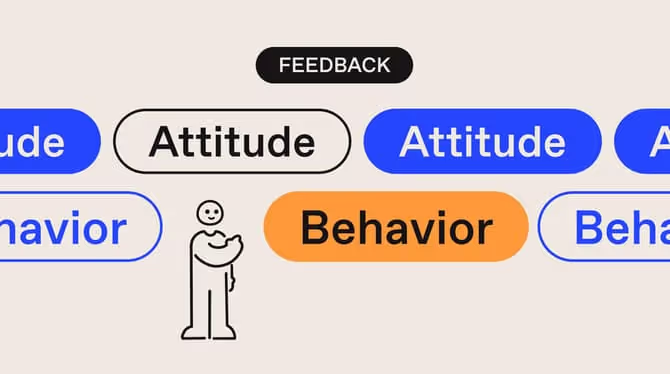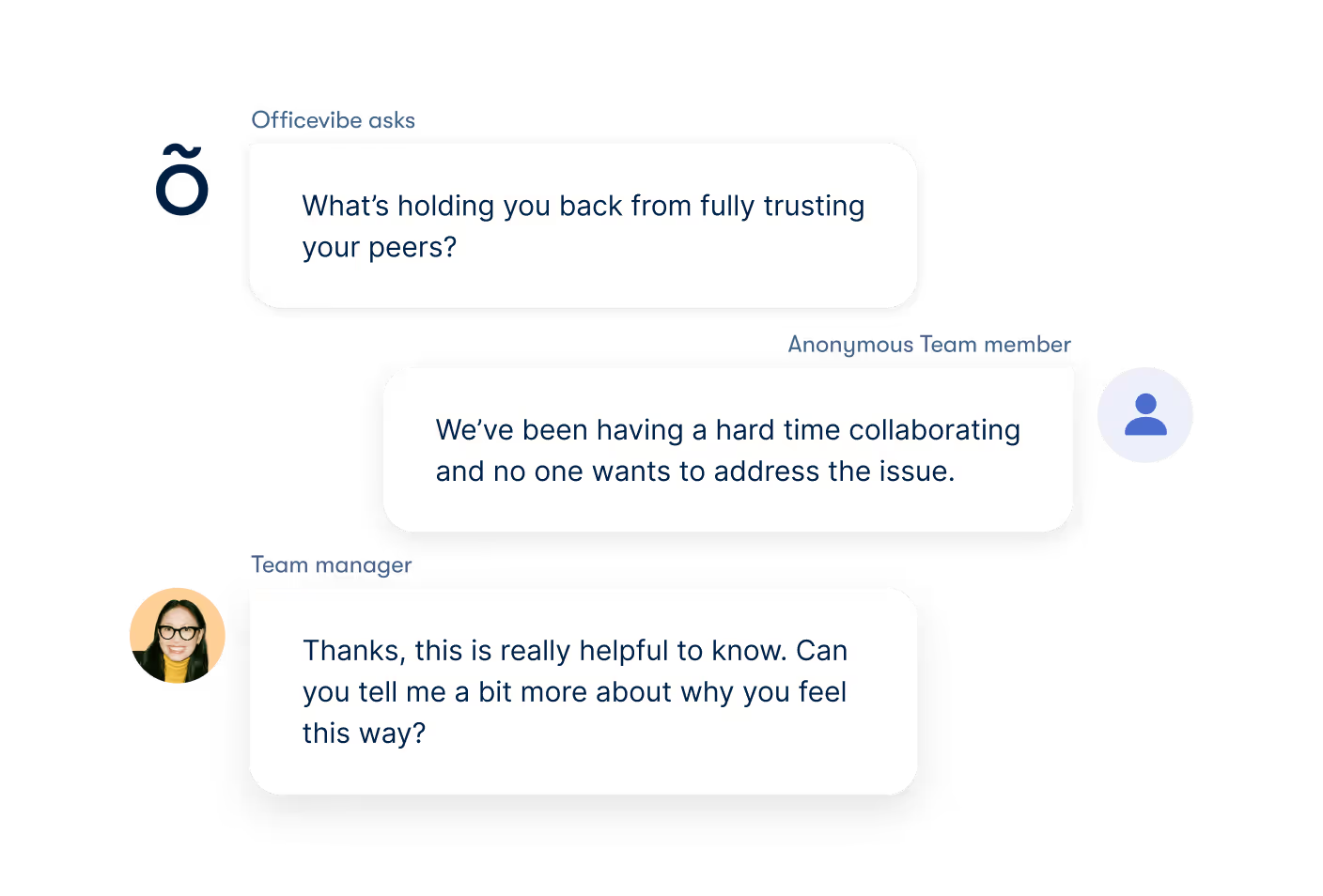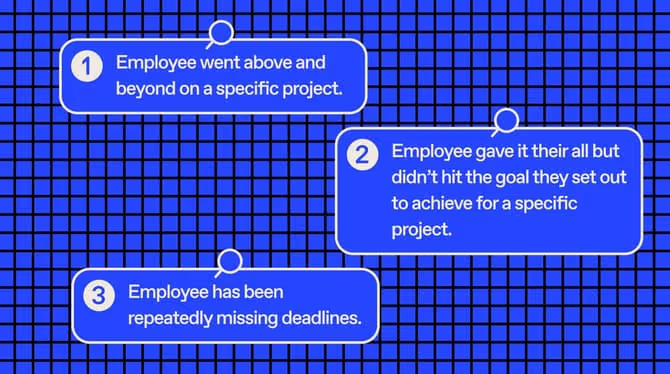How to give employee feedback on attitude and behavior

Discover Workleap Officevibe's benchmark report on 12 key employee engagement metrics

Success in the workplace is about more than mere aptitude. It turns out that having the right attitude is essential, too. As a leader, you aim to set your team up for all aspects of success, and to get there requires providing feedback – both positive and negative.
Once you’ve recognized that feedback can be impactful, the next step is figuring out the best approach to provide employees with actionable advice that supports their growth and development while benefiting your company as a whole. This article includes a framework that will help you foster successful employees by providing helpful feedback, specifically on behavior and attitude.
Feedback for employees with a positive attitude
You already know that a regular pat on the back for a job well done is Management 101. But have you made it a habit to acknowledge an employee when they demonstrate a supportive attitude?
Sharing positive feedback with the employees who maintain a stellar attitude makes them feel seen. Acknowledging their good work and the cheerful attitude with which they approach their duties can inspire your people and motivate them to excel.
While a simple “great job!” can suffice in a pinch, we recommend adopting the SBI Framework, an abbreviation for Situation-Behavior-Impact. This model gives you a template for providing specific employee feedback that clarifies the significance of the employee’s behavior, avoiding ambiguity about what inspired the praise.
{emphasize}
SBI is best demonstrated with an example:
A client called to express frustration about the delay in their order (situation). You remained calm and assisted them with poise and grace (behavior). By the end of the conversation, your client was smiling and expressed that they didn’t mind waiting a few extra days.
{emphasize}
You can use this technique to point out when a high-performing employee stepped up with a great outlook. Describe how the employee’s actions positively impacted other team members, embodied the company’s mission, or diffused a stressful situation.
You can also practice SBI when offering constructive criticism using the same formula.

How to evaluate an employee with a bad attitude
Praising an employee for having a great attitude can make you feel like you’re floating on cloud nine. By contrast, sharing negative feedback with an employee who needs improvement in this area could feel like discipline.
The good news is that it doesn’t have to be that way. If you have a difficult employee, you can potentially turn the situation around with constructive feedback. By taking a systematic approach to feedback, you’ll be able to gauge whether a direct report’s attitude can improve or you have a poor performer whose lousy behavior is acting as a heavy anchor on your team spirit.
Identify the type of negative attitude your employee is demonstrating
A bad attitude can manifest itself in more than one way. Symptoms can include one (or a combination) of the following:
- Refusing to take on tasks because it’s “not my job”
- Blaming others for mistakes or shortcomings
- Failing to take initiative
- Not being fully present in meetings or activities
- Acting disrespectfully toward managers or colleagues
Once you identify these behaviors, you’ll be equipped to provide feedback that helps the employee develop and maintain traits that better serve your team.
Avoid attacking personality
Calling attention to areas where someone needs to improve workplace performance can put an employee on the defensive and make them feel like they’re being attacked. Avoid making the feedback personal, and instead, focus on the negative behavior.
{emphasize}
Instead of: You’re always five minutes late for meetings. This disrespects your colleagues’ time.
Try saying: I noticed that you’ve been struggling to get to our Monday meetings on time. Do you have other responsibilities or something else on your schedule that conflicts with that time?
{emphasize}
Be specific and provide examples
Feedback is most helpful when it’s specific. Avoid generalizations, and focus your observations on concrete events.
For example, you could say something like, “I appreciate how passionate you are about the Oxford comma, but when you called James out for not putting it in his PowerPoint presentation, those words were harsh.” It points to a specific incident that your employee can recall.
By contrast, “your outbursts at meetings violate our company policies” might leave your employee wondering what you’re referring to, especially if they don’t think their actions have ever constituted an “outburst.”
Be direct
It’s not always easy to deliver feedback to someone, but wavering is not helpful and dilutes the quality of your message.
Often, managers try to soften the blow by sandwiching their criticism between two statements that sound like praise.
For example: "You do great work (praise), but when you consistently deliver your projects past the deadline without communicating the delay (criticism), it hurts our company reputation even though the projects themselves are done exceedingly well (praise)."
Here, the manager is trying to get the point across that late delivery and lack of communication are unacceptable. Still, the criticism gets lost in an attempt to acknowledge what the person does well. The employee could easily gloss over the crucial feedback about work performance and never improve delivery time.
End on a high note
Managers need to encourage their team and motivate them to be their best selves. Even if the feedback serves to identify areas of negative behavior, you should still provide some encouragement.
Wrap up employee evaluations with ideas about how the employee can improve. Explain that you want them to succeed at the company and that growth is a continual process. Set goals and measure progress routinely to ensure that your employee is on the right track to meeting expectations.
Performance reviews – what to say to an employee with a negative attitude
As the term suggests, an employee performance review often focuses more on actual work performance and less on attitude. If performance evaluations are only done on an annual basis, there’s bound to be a lot of material to cover.
Addressing an employee’s poor attitude could take a back seat to more concrete metrics, especially if your employee tries to steer the conversation away from the topic.
- Make sure they know in advance that attitude is something you evaluate.
Include a list of topics that you'll cover in the performance evaluation. This proactive measure avoids an ambush and sets the stage for a seamless transition into a discussion about attitudes. - Discuss how their approach affects results.
Point out examples where their lack of cooperation or bad behavior impacted coworkers or the company’s bottom line. - Focus on the positive.
Offering balanced feedback helps create a sense that you're on your employee's side. You respect them as a person, even if you don't appreciate some aspects of their behavior. - Listen to their point of view.
Sometimes what you don’t say is just as important as what you say. Give your employees time to share their perspectives or side of the story. Even if you disagree with their approach, take the time to listen. You may get insights that help address the negativity issue even more effectively.
🔥 Pro-tip: Implementing an employee feedback tool can also help you get points of view anonymously. Officevibe facilitates this process by collecting employee feedback on your terms and making it easy for you to disseminate the data. - Begin sentences with "we" and "I," not "you."
For example, say things like, "I feel like you don't respect the other employees that work here because…" and "We noticed that you've been critical of your coworkers." Avoid accusatory statements like, "You are failing to meet meeting attendance expectations."

Providing employee feedback on attitude outside of the performance review
You don't have to wait for an annual performance review to provide feedback to your team. In fact,
Officevibe data suggests that feedback shouldn't be limited to the confines of a formal performance review. Instead, a more organic process can benefit employees because they get more timely feedback that they can put into practice right away.
[ov_cta id="5116548"]
Adding regular coaching sessions can dramatically improve your company culture. Employees stay motivated year-round and are engaged in a constant feedback loop. Contrast this to an annual review process where employees might only focus on their attitudes in anticipation of a performance review tied to a yearly salary increase.
One-on-one meetings
Addressing negative attitudes is best done in a one-on-one, private setting. To make these meetings as stress-free as possible, we recommend following a couple of guidelines:
1. Provide some (but not too much) notice.
You'll want to give the other person some time to prepare, but you also want to avoid having them stewing in turmoil while they imagine the worst possible outcome. We suggest scheduling up to one business day or a few hours in advance.
2. Create and share a meeting agenda.
Outline the talking points you'd like to cover and share the agenda with your employee. Invite them to add any issues they'd like to address in the meeting as well.
3. Take notes.
Document what you discussed and your employee's responses. Keep a record of the conversation for annual performance reviews or discussions with Human Resources.
{emphasize}
Tip: Officevibe's one-on-one meeting software lets you schedule these conversations, create shareable and editable agendas, centralize notetaking, and set up recurring meetings. The software even includes templates that you can use to help facilitate difficult conversations.
{emphasize}

Informal chats
Sometimes a formal meeting isn't the best way to discuss negative attitudes. This is especially true if the behavior needs to be addressed immediately.
The key to remember with an informal chat is timing. There are a couple of things to consider here:
🧯 If tempers are hot, allow everyone to cool off before approaching your employee.
⌛ Although the chat isn't exactly a formal meeting, you'll still want to give the person notice and make sure they're in a good headspace to have a constructive conversation.
{emphasize}
When you need to act promptly, another way of providing feedback is through emails. The key is to give constructive criticism and show your are supporting your employee. We have a few sample emails to provide feedback on behavior to get you covered.
{emphasize}
How to talk to an employee about attitude in a constructive manner
Remember that famous saying? It goes like this: Do unto others as you would have them do unto you.
Our best advice to approach constructively discussing an employee's attitude is to put yourself in their shoes. How would you want your colleagues to approach you if you were grumpy, frustrated, or having a tough time at work?
As you plan your talking points, consider your employee's perspective and deliver your message compassionately.
Encourage an attitude adjustment
Suggesting that someone adjust their attitude might seem easier said than done, but some gentle approaches can help the conversation be less awkward and more constructive.
Understanding the source of the negativity can go a long way toward fixing the root cause.
Consider these possible scenarios:
1. They're unaware of their bad attitude.
It's possible that your employee had no idea they were behaving in an unacceptable manner. We all have blind spots!
2. They're dealing with a personal challenge.
Maybe a family member is sick, they're having relationship problems, or there's another obstacle that's made life more difficult for them. It's natural to have a shorter fuse when curveballs are thrown our way, but your employee should understand that taking it out on coworkers is not the best outlet.
3. Other employees have complained.
As a manager, you can't be everywhere at once, so you might not have directly observed the workplace behavior. Gather evidence about the incidents and approach your employee with examples of what happened and suggestions for improvement.
Become a pro at providing employee feedback
When employees show up with a positive attitude, they foster an environment of teamwork and high performance, learn new skills quickly, and are motivated to be their best selves.
Even though it can be challenging to offer constructive criticism in the workplace, it's an integral part of personal and career growth. It also takes practice, so we encourage you to put the tips in this article to good use in your management style.
Give HR and managers the clarity, confidence, and connection to lead better every day.


%20(1).avif)


.avif)
.avif)





.png)


